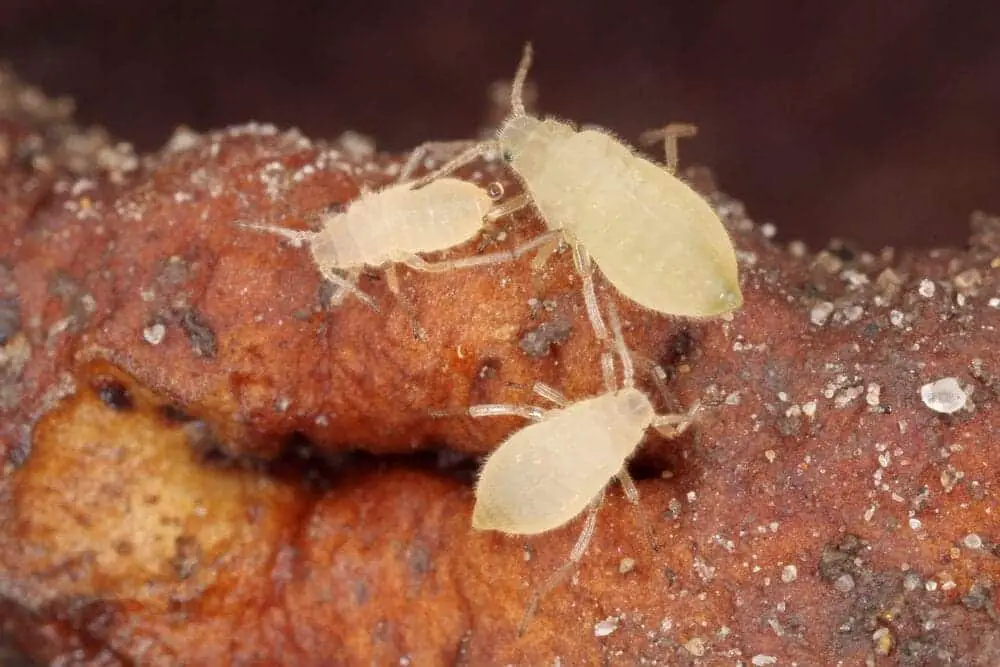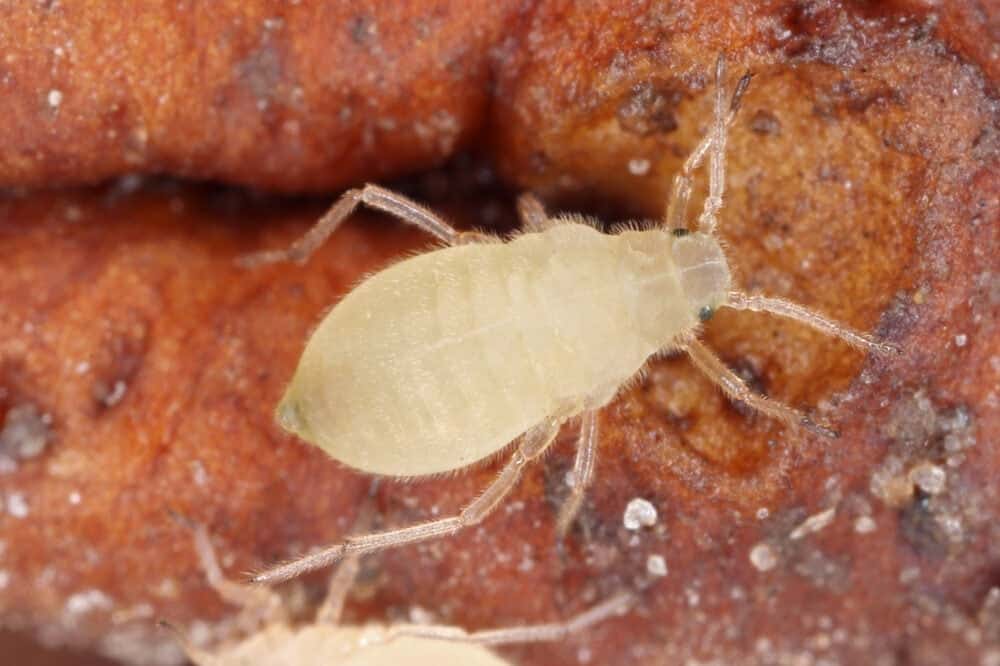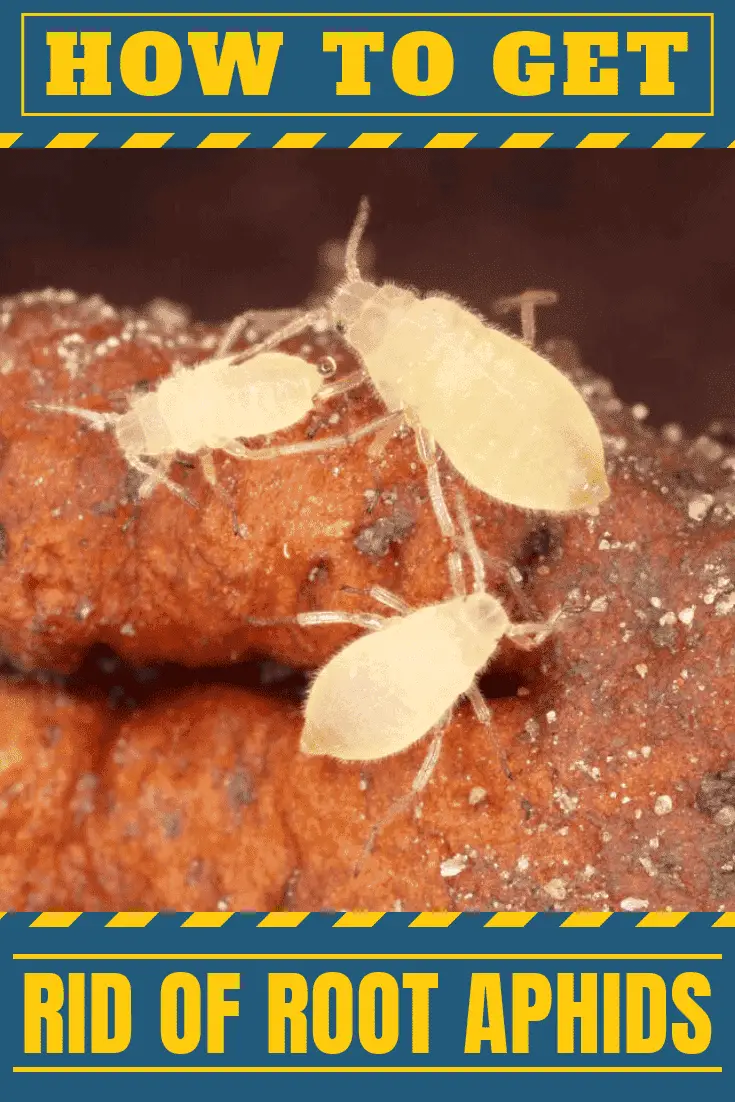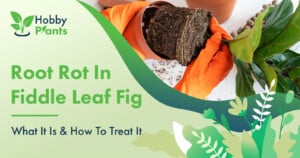Root aphids may be small, but they’re destructive in large numbers. To ignore the first signs of root aphids is to kiss your plants goodbye.
They bury themselves into the soil and attack the roots, which is the most delicate part of any plant. They are a menace to every gardener. If they’re not your problem yet, it’s best to prepare if they do arrive. We’ll teach you about aphids and how to combat then so you’ll be ready if they appear in your garden.
What do aphids look like?
When you are in your garden, or you’re looking at your houseplants, be sure to check periodically for root aphids. This is so you can spot them right away and catch them before they multiply. Root aphids are tiny; about 1mm long. They come in a few different colors like brown, orange, green, or yellow. If the aphids are yellow, their bodies will be see-through. The aphids come in different colors because there are three species of root aphids: the Hawthorne aphids, the tulip bulb aphids, and the carrot aphids. Their bodies are teardrop-shaped, and they are often mistaken for mealybugs, but mealybugs are much larger.
One of the reasons that you want to catch root aphids before their numbers multiply is because once they reach maturity, they can grow wings and fly. They will be able to travel everywhere in your garden. If your plants are indoors, then they will fly around your home.

How do aphids kill plants?
The root aphid buries itself into the soil and eats the roots of its target plant. Although they concentrate on the roots, they will sometimes climb up the plant and eat the stems and leaves. They must do this if there is a large amount of aphids in one area. They chew on the roots of their plant and eat everything in their path. They also inject their saliva into the flesh of the plant, causing it to rot from the inside.
What are the signs that your plants have root aphids?
Since roots transport nutrients from the soil to the rest of the plants, one way to know if you have root aphids is your plant doesn’t look good or it has stunted growth. Yellow leaves, lanky stems, and a withy bloom are all caused by lack of nutrition. Dig under the dirt, and if you see tiny bugs crawling around in the soil, then you have aphids.
If you’re looking at the soil of your plant and you see white patches along next to the base of your plant, then you have aphids. They leave behind a waxy white substance along with the roots and root ball of their target plants.
Another way to know if you have a root aphid problem is you suddenly have many ants scurrying around a particle plant. When root aphids poop, they leave behind a sticky substance called honeydew. Ants love honeydew and will hunt for it. If you see ants surrounding the base of a plant and digging into the soil, that is a sign you have root aphids.
If you have a large number of aphids, it is probably too late to save your plant. If you want to try, you have to remove the entire plant from the infested soil. Clean the root, and don’t let a single aphid live. Repot it in brand new soil or move the plant far away from the damaged section of your garden.

Plants and aphids
Plants that attract aphids are called trap plants. Gardeners use these plants to lure root aphids away from plants that they love to eat. Sunflowers, nasturtiums attract root aphids easily.
There are very few plants that root aphids don’t like. These plants are mostly from the Allium family. This plant family contains garlic, leeks, and chives. They don’t enjoy eating cattails, cilantro, or fennel either.
Ways to kill aphids
Now, let’s go over how to kill these terrible little pests before they destroy your plants and infest your home.
Nematodes
If you want to get sci-fi to kill an infestation of root aphids, you can use nematodes to kill them. Although they look like worms, they are not part of the worm family. Nematodes eat tiny plants that can only be seen through a microscope. But these tiny crawlers are the predators of the aphids and can kill them quickly. Within a few days of releasing them, you won’t have an aphid infestation anymore. They kill aphids by paralyzing them with a bit and then eating them. You can buy nematodes online or in hardware stores. Sprinkle them around the plant and leave them alone for a few days. Keep adding more nematodes until you see a marked absence of aphids.
Insecticides
If you have plants that have been bred to tolerate insecticides, then you can use insecticides to kill root aphids. It is not recommended to use powerful chemicals against these bugs since that would be overkill, But a mild one is best. Remember that insecticides can be absorbed into the soil, so the aphids underneath the soil will die too.
Neem oil
This oil should be in every gardener’s supply closet. Neem oil affects most bugs because it contains an irritant that forces the bugs to flee. For some bugs, the neem oil is so strong that the fleeing bugs die. It is a natural substance and won’t hurt your plants, even in high concentrations. Add neem oil to a water mixture and place the mix in a spray bottle and spray the infested plant and soil with it.
Keep reading:
Water
Spray every plant that has aphids with water, so the aphids either die or fall off the plant. Soak the soil before you start spraying the plant. When you spray the plant, the aphids will fall off the branches and leave and fall into the water and drown. The aphids that are buried in the soil will also drown. You should also rinse off all of the leaves and stems of the plant to remove the root aphids that have crawled up it.

Victoria is the owner and main author of hobby plants. She loves spending her free time in her garden planting and taking care of her plants. Victoria hopes you enjoy the content here!
![How To Get Rid Of White Bugs In Soil? [PLAN OF ACTION] How To Get Rid Of White Bugs In Soil? [PLAN OF ACTION]](https://www.hobbyplants.com/wp-content/uploads/2022/08/white-bugs-in-soil-300x158.jpg)

![How Big Do Different Types Of Azaleas Get? [Find Out Here] How Big Do Different Types Of Azaleas Get? [Find Out Here]](https://www.hobbyplants.com/wp-content/uploads/2022/09/how-big-do-azaleas-get-300x158.jpg)